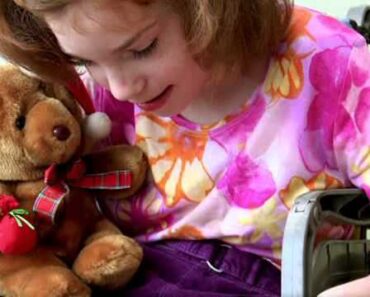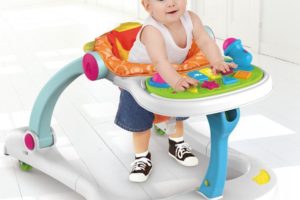image: Shutterstock
Have you noticed your toddler walking on tiptoes? This is called toe walking and is normal in children who are learning to walk (1). The toddler uses the toes and balls of the feet to walk without letting the heels touch the ground (2).
Tiptoe walking in toddlers is common between the ages of 10 and 18 months when they learn to balance body weight on their feet (3). It resolves once the toddler learns to walk. However, it may persist up to six to seven years in some children. Read on to learn about the causes of toe walking in toddlers and when to be concerned about it.
Why Is Your Toddler Toe Walking?
Most cases of toe walking in toddlers are idiopathic, which means that the cause is unknown (4). Many toddlers walk on their toes out of habit or only for the sensory stimulation it elicits. This is often evident when the child also walks normally with the heels on the ground.
Certain conditions and problems may also lead to toe walking in toddlers.
1. Short Achilles tendon: Toddlers with short Achilles tendons cannot stretch their feet enough to make the heels touch the ground. It leads to partial or complete toe walking.
2. Low muscle tone: Toddlers with low muscle tone may prefer toe walking. For instance, toddlers with poor abdominal muscle strength may walk on toes to maintain balance (5).
3. Cerebral palsy: If a toddler does not stop toe walking by three years of age, it may be a sign of spastic or hypertonic cerebral palsy (6).
4. Muscle and nerve disorders: Certain disorders could affect the form and functions of muscles, nerves, or connective tissues, leading to toe walking. An example is Duchenne muscular dystrophy, which causes the toddler to walk on toes due to shortened Achilles tendons (7).
5. Developmental abnormality: Toddlers who show developmental abnormalities, such as developmental dysplasia of the hip or leg length discrepancy, tend to show unilateral or bilateral toe walking (8).
Toe walking is often associated with autism since many toddlers with autism may walk on toes for sensory stimulation. However, there are several signs of autism, and toe walking does not always indicate an autism spectrum disorder. Speak to a pediatrician who will run specific autism-related tests at different ages to diagnose autism.
What Is Idiopathic Toe Walking?
Idiopathic toe walking is habitual or behavioral toe walking and is often seen in toddlers up to three years (9). It is the most common reason for toe walking in toddlers. It is called ‘idiopathic’ since there is no specific underlying cause, condition, or issue behind it.
Idiopathic toe walking is commonly noticed in healthy toddlers, who often do so only when they walk bare-footed on surfaces that provide increased tactile sensations, such as grass or cold tiles. The toddler may often stop toe walking when walking with shoes.
Factors That Contribute To Idiopathic Toe Walking
The cause for idiopathic toe walking is unknown. However, a few factors may contribute to it (9).
- Increased tactile sensations on certain surfaces
- Desire to flex leg and foot muscles
- The need to maintain balance and gait on certain surfaces
- Visual perception of certain surfaces triggering careful toe walking
- Learned habit, especially if the toddler’s siblings walk on toes
When To See A Doctor?
Toe walking usually does not require any medical attention. Nevertheless, you may consult a doctor in the following scenarios.
- Toe walking persists beyond the age of three. In such cases, it could be due to an underlying problem.
- The toddler displays other signs of muscle, nerve, or connective tissue disorders. Some common signs include tight neck muscles, poor posture, and awkward gait.
- You observe repetitive behaviors, such as flapping hands, swaying, hitting head to a surface, or rocking back and forth when seated.
- The toddler has other issues, such as seizures, inability to self-feed, or poor language skills for their age.
Does Toe Walking Require Treatment?
Idiopathic toe walking does not require treatment since it is part of the toddler’s normal physical development. The doctor may consider treatment if the cause is a condition or problem. In such cases, treatment or management of the underlying cause could stop toe walking.
Below are some interventions that could be taken specifically to address toe walking (10).
1. Physical therapy: It is a non-invasive treatment and could be the first choice. Physical therapy involves stretching the tight muscles and tendons to reduce toe walking. These exercises can be performed at home regularly.
2. Leg casts: A cast is applied to the legs for one to two weeks. It helps stretch the tight muscles and bring the foot and ankle in a better position, enabling normal waking.
3. Braces: A brace that keeps the child’s foot at 90 degrees may be applied to stretch the muscles and tendons. Ankle-foot orthotics (AFO) is a common type of brace that could encourage the toddler to place the foot flat on the ground.
4. Botox: Botox injections could be considered if toe walking is due to muscle disorders, such as cerebral palsy. It could help relax tight muscles when used in combination with casts or braces, enabling the child to walk on their heels.
5. Surgery: Surgical treatment could be considered in cases where toe walking is due to innate tissue deformity. For example, surgery could be helpful if the toddler is born with a short Achilles tendon. The lengthening of the Achilles tendon through surgery could improve the foot’s range of motion.
Are There Complications Of Toe Walking?
Untreated toe walking due to underlying problems may increase the risk of the following conditions (11).
- Excessive tightening of the muscles and tendons of the feet
- Excessive abnormal forces on the bones and ligaments of the knees, hips, and lower back, resulting in lower back pain
- Poor coordination and balance, resulting in frequent falls and injuries
- Inability to participate in certain sports and activities, impacting the child’s self-esteem
How To Help A Toddler Who Is Toe Walking?
Parents may consider the following exercises and activities to encourage the toddler to walk with their feet flat on the ground (12).
- Ask your toddler to walk with their toes towards the ceiling and heels on the ground. You can support the toddler while they walk this way.
- Get your child to push the laundry basket or a toy basket that will force them to keep their heels down while walking.
- Some fun activities, such as picking up marbles with their toes and putting them into a bucket or pop bubbles with their toes, force them to balance their body on one foot with their heel down.
- You can encourage your child to perform wall slides where they lean their back against the wall with their legs outwards. They must slide their back down until their knees form a 90-degree angle. Ask them to stay in this position for 10-15 seconds.
- Encourage your child to walk up an incline or a steep slope, hop on one foot on the grass, or jump for 10 seconds at a time while keeping their heels on the ground.
Toe walking in toddlers is common when they are learning to walk. As the toddler grows older, they walk the usual ways with less dependence on their toes. Most cases of toe walking are idiopathic. However, if the toe walking persists beyond the age of three or the toddler displays other possible signs of muscle or nerve disorders, consult a pediatrician promptly.


































